|
|
|
Sort Order |
|
|
|
Items / Page
|
|
|
|
|
|
|
| Srl | Item |
| 1 |
ID:
175072
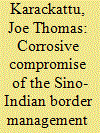

|
|
|
|
|
| Summary/Abstract |
India and China have entered a new low in their bilateral relations. Having fought a war in 1962, it took over three decades for both countries to achieve normalcy at the borders, aided by a series of border management agreements and protocols to maintain tranquility along the border areas. However, the June 2020 Galwan clashes have changed that permanently. This paper argues that the current escalation of border clashes is both a symptom and consequence of the breakdown of the bilateral border management framework which has been dented since the 2017 Doklam standoff between both countries. Delving into diplomatic history relating to Doklam and Galwan, the findings point to the need to correct the epistemic criteria used to reproduce claims of an unambiguous boundary between India and China by both countries, in order to ensure abatement of similar outcomes.
|
|
|
|
|
|
|
|
|
|
|
|
|
|
|
|
| 2 |
ID:
175069
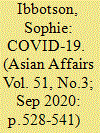

|
|
|
|
|
| Summary/Abstract |
In this article I will discuss three areas: Central Asian countries' immediate responses to the COVID-19 crisis, including the current public health situation; the short- and mid-term economic impact of the global shutdown and slump in oil prices; and what the countries' responses demonstrate about their regimes, relationships, and places in the world today. I will compare and contrast the five countries throughout the article, drawing attention to the most relevant and interesting examples of policy and outcome, with supporting statistics and commentary as relevant. Kazakhstan, Kyrgyzstan, Tajikistan, and Uzbekistan will get the bulk of the analysis, which is a reflection of the difficulty of getting credible information about the COVID-19 situation in Turkmenistan.
|
|
|
|
|
|
|
|
|
|
|
|
|
|
|
|
| 3 |
ID:
175070


|
|
|
|
|
| Summary/Abstract |
South Asia, a poor, densely-populated region with weak public health infrastructure, appears highly vulnerable to COVID-19. But cases and fatalities have so far remained relatively low in the region. The low case-load is unlikely related to climate, malaria exposure or tuberculosis vaccination, as has been suggested. Insufficient testing in South Asian countries has probably disguised the true extent of the outbreak. Younger demographics might also explain the region's low fatality rate. Although the health impact of coronavirus has not been as devastating as some feared, the social, economic and political consequences are already severe. The pandemic is exposing and exacerbating some of the region's major weaknesses, including poverty, gender inequality, persecution of minorities, authoritarian governance, and geopolitical competition. In that sense, coronavirus is both a “mirror”, which reflects South Asia's problems, and a “catalyst”, which intensifies them.
|
|
|
|
|
|
|
|
|
|
|
|
|
|
|
|
| 4 |
ID:
175075
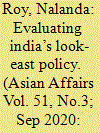

|
|
|
|
|
| Summary/Abstract |
This article seeks to analyze whether the United Progressive Alliance government in India (UPA, which was in power from 2004–14) was successful in implementing its Look East Policy (LEP). It will discuss to what extent it was effective in realizing its vision of a community of nations conscious of their historical ties, cultural heritage, and connective identity in the Asian platform. This article argues that the government’s idea of a ‘shared destiny’ has formed the core of an emerging ‘identity’ in India, and has acted as the main anchor of India's approach towards the South East Asian region. The paper also examines whether the UPA government was successful in its vision of strengthening institutional cooperation, capability, and connectivity, in the region and how the implementation of the LEP has impacted on India’s economic and security interests.
|
|
|
|
|
|
|
|
|
|
|
|
|
|
|
|
| 5 |
ID:
175066
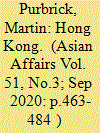

|
|
|
|
|
| Summary/Abstract |
This article explains why Hong Kong is a “torn city” with divisions in society resulting from the historical alignment of the city with the West, and the economic and political integration with Mainland China that reflects the vision of the governing and business elite of the city being part of the rise of China. The “torn city” reflects cultural divisions between the Western model of capitalism and governance and the communist system of the People's Republic of China. This cultural division and the resultant popular discontent have been exacerbated by poor governance in Hong Kong with a local government and the business elite that has resisted changes in governance to improve the welfare of those of the population who have not benefitted from economic growth in the city.
|
|
|
|
|
|
|
|
|
|
|
|
|
|
|
|
| 6 |
ID:
175076
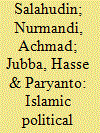

|
|
|
|
|
| Summary/Abstract |
This article analyses the polarisation of Islamic groupings in Indonesia which have taken place since 2017. It reviews the situation from the 2017 gubernatorial elections in Jakarta and the incident of the Ahok Video, during which the various Islamic factions were united, up to the 2019 elections, during which they polarised around the different presidential candidates and were unable to present a united front. This article analyses the division of Islamic groupings in Indonesia into traditionalist, fundamentalist and modernist, and looks at the interactions within them and between them on social media towards the 2019 campaign to better understand their positioning.
|
|
|
|
|
|
|
|
|
|
|
|
|
|
|
|
| 7 |
ID:
175074
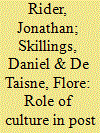

|
|
|
|
|
| Summary/Abstract |
This article presents a discussion about the role of cultural heritage in post-emergency reconstruction. The three authors, presenting viewpoints from their own experience in the field, argue that cultural heritage has significant potential to foster economic development, especially among communities living in remote geographic areas. Cultural heritage provides comparatively unique opportunities (especially in countries like Afghanistan) for engaging with marginalised groups such as women, youths and those from low-income communities. The article discusses the potential for cultural heritage in these situations to empower local communities, but also discusses the role that international organisations and private enterprise can play with regard to cultural heritage in post-conflict and post-disaster recovery.
|
|
|
|
|
|
|
|
|
|
|
|
|
|
|
|
| 8 |
ID:
175071
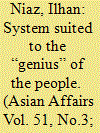

|
|
|
|
|
| Summary/Abstract |
In recent months there has been an effort to reignite debate about the suitability of a federal parliamentary system and argue that it needs to be replaced by a centralized presidential form of government. This has led to sharp reactions from those who favour a continuation of parliamentary government in Pakistan especially with regard to the strong federal provisions of the Eighteenth Amendment (2010) to the Pakistani Constitution, which granted greater autonomy to the provinces and undid many of the changes imposed by military rulers. This paper examines the original version of this debate from Pakistan's experience in the 1950s and 1960s with the aim of identifying and discussing the rationales of those in favor of a presidential Pakistan and the price that the country paid for undermining parliamentary government.
|
|
|
|
|
|
|
|
|
|
|
|
|
|
|
|
| 9 |
ID:
175073


|
|
|
|
|
| Summary/Abstract |
Asia, with the world's largest population, extensive natural resources and fast growing economies, has become one of the world's most dynamic regions and a theatre for a variety of actors, distinct interests and national armament efforts. Focusing on East Asia, the most significant regional powers are the US and China, which although they are becoming competitors, also depend on each other over a large number of economic and regional security issues (e.g. North Korea). But on the whole, China and the US are struggling for regional hegemony and influence. They are pursuing large-scale armament efforts and investing heavily in emerging military technologies, thereby feeding the risk of violent confrontations and threatening stability and peace. In this connection, US Missile Defence represents one of China's major concerns. Focusing on US Missile Defence efforts in the Western Pacific region, this article presents an overview of the currently-deployed systems and plans for further development. It analyses the technological capabilities of associated sensor and interceptor elements and estimates their individual abilities to contribute to an integrated US Missile Defence architecture in this region. Finally, this state of short- to mid-term US Missile Defence capacity in the region is situated in relation to its impact on nuclear deterrence and strategic stability, taking account of both Chinese security concerns and US security interests. Assuming that both the US and China have a common interest in regional and strategic stability, the article concludes by discussing arms control measures. It suggests concrete options for confidence building and proposes achievable steps, which would promote a Sino-American discourse on joint security issues and strengthen crisis stability as well as regional security.
|
|
|
|
|
|
|
|
|
|
|
|
|
|
|
|
| 10 |
ID:
175068


|
|
|
|
|
| Summary/Abstract |
This article looks at the prospects for peace in Yemen. It offers a comprehensive overview of the current situation, including the strength of the Huthis, the interests involvement of Iran, Saudi Arabia, the UAE and western powers, the individual situation of the various regions and provinces of Yemen, its economy, the question of terrorist presences in the country, and the attempts made to reach a settlement between all sides. The article argues that at present the prospects for a peaceful cessation of the conflict are poor and that it is likely to continue for the foreseeable future.
|
|
|
|
|
|
|
|
|
|
|
|
|
|
|
|
| 11 |
ID:
175067


|
|
|
|
|
| Summary/Abstract |
Murray MacLehose, the 25th Governor of Hong Kong, was the longest-serving Governor in the history of Hong Kong. MacLehose proposed and implemented a series of policies that brought significant reforms to Hong Kong. These reforms included housing, transportation, anti-corruption, welfare, and education. The reforms did not only improve people's living standards, but also created for Hong Kong people a sense of belonging to the colony. While the mainstream of Hong Kong society claimed MacLehose was a respected governor, was MacLehose's ten-year-governorship in actual fact praiseworthy? This article will revisit MacLehose's governorship and show that MacLehose was not as perfect as the locals think – he was even reluctant to implement some reforms, particularly political reforms, anti-corruption and social security. However, this was because he was trying to balance local and British interests within the colony. He indeed worked hard to perform his duty and defended well Hong Kong's interests during his governorship.
|
|
|
|
|
|
|
|
|
|
|
|
|
|
|
|
|
|
|
|
|